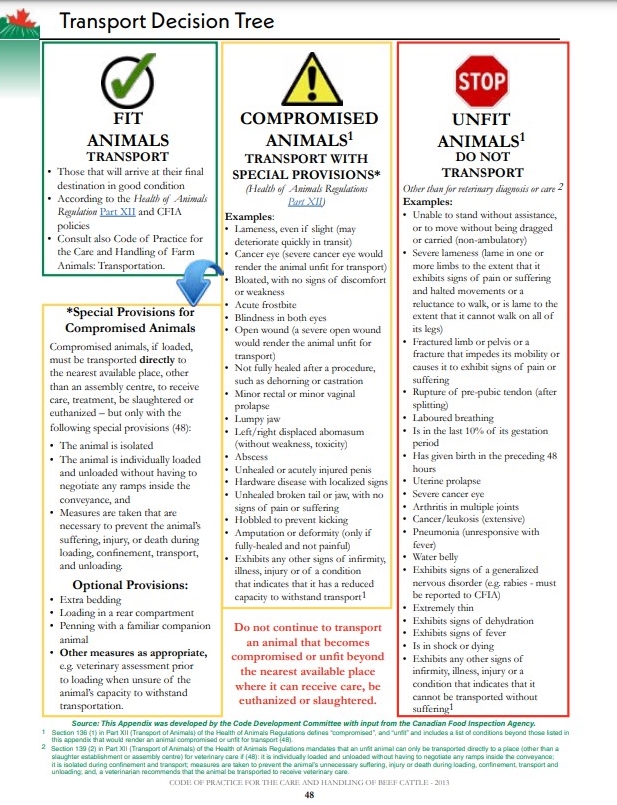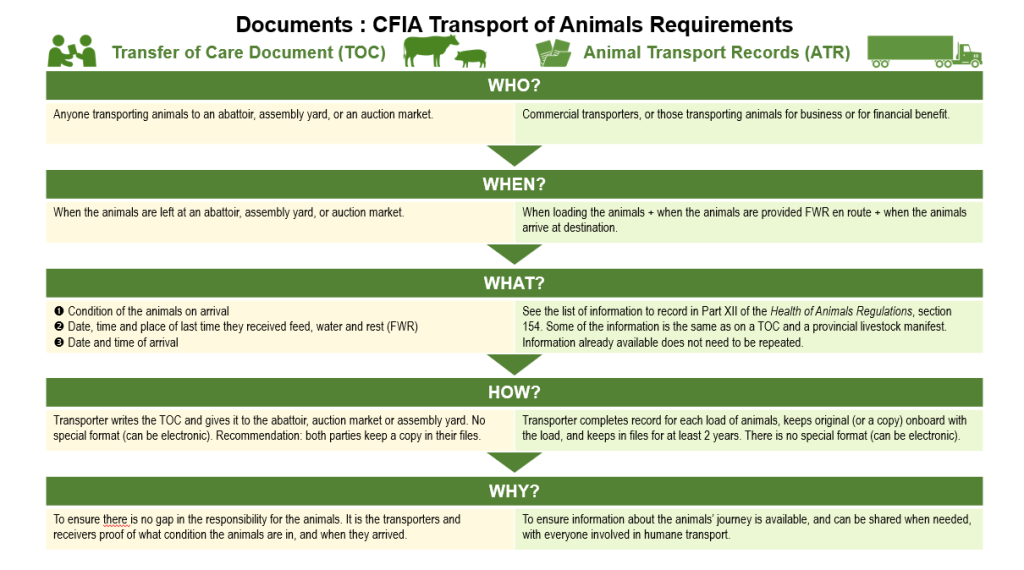Updated Livestock Transport Regulations and What You Need to Know

Changes to the Transport of Animals Regulations (Part XII of the Health of Animals Regulations) came into effect in February of 2020 and are being actively enforced.
There are four major changes in the new regulations focusing on:
- categorizing animals fit for transport,
- record keeping for transporters,
- required feed, water and rest times and
- contingency planning.
Categorizing Animals Fit for Transport

It is a legal responsibility of anyone hauling livestock to be able to recognize and place the animals in their care into the three categories before loading them on the trailer for transport:
- fit for the intended transport,
- unfit for transport or
- compromised.
Record Keeping for Transporters
It is important to not only categorize animals, but document them as well, as animals will need to be reassessed along the journey.
Two new documents are required for transport. These documents focus on recording the status of animals before they are loaded, in transport and upon transfer of care. However, one document may be used to serve both purposes as long as all required information is included.
Animal Transport Record – This record must include:
- the shipper’s name and address,
- driver’s name, license and registration,
- trailer floor area and when/where the trailer was last disinfected,
- animal description including number, weight, time of loading, if animals are fit for transport and any special provisions for any compromised animals and
- the last time the animals received feed, water and rest.
This document is to be written and retained by anyone transporting animals in the course of business for a period of two years.
Transfer of Care Record – This document is only needed for auction marts, slaughter facilities or assembly centres and must include the following information:
- date and time of arrival,
- condition of animals and
- date and time of the last feed/water and rest.
This document is to be retained by the receiver for a period of two years. The transfer of care from the transporter to the receiver occurs immediately upon acknowledgement of the shipment and the accompanying Transfer of Care Record.

Required Feed, Water and Rest Times
Changes around maximum feed, water and rest (FWR) intervals are also part of the regulations. The FWR interval requirements depend on the species and class of animals being hauled. Fit and mature (weaned) cattle may be transported for 36 hours between rest periods. At this time, the CFIA does not plan to enforce this maximum transportation time provided the destination has been reached within a maximum 40 hours. Comparatively, a load with any young (too young to be fed exclusively hay or grain) or compromised calves must stop every 12 hours. (See definition of fit and compromised animals in the Decision Tree graphic from the Canadian Food Inspection Agency at the beginning of the article.) Additionally, any animal under nine days of age may only have one direct trip of 12 hours and may not go through an auction mart.
The definition of travel time also changed. In the past, travel time started at loading and ended at unloading. The updated regulations now start the clock at the last time a period of rest including feed and water was initiated and does not end until feed, water and rest are provided at the rest stop or final destination.
Contingency Planning
When transporting an animal in the course of business, contingency planning will need to be considered for every trip. This can be a verbal or written plan and must cover all predictable natural or manmade scenarios that may halt or delay a trip. Planning needs to consider how to provide rest, protection from the elements, feed, water and safety in the event of any unplanned circumstances.
Before heading out on the highway, it is important to know the rules. Demonstrating compliance requires documenting the steps taken to ensure the welfare of the animals in your care and keeping records of any issues. If in doubt, write it down. A smooth trip with no delays is worth the time and effort.
ADDITIONAL RESOURCES
- Livestock Transportation in Canada (Canadian Food Inspection Agency)
- Health of Animals Regulations: Part XII: Transport of Animals – Regulatory Amendment Interpretive Guidance for Regulated Parties (Government of Canada)
- Transporting Animals? Health of Animals Regulations Section 153 Transfer of Care (Canadian Food Inspection Agency)
Disclaimer: Information was accurate and as per CFIA regulation at the time of the publishing date. Regulations and regulatory guidance may be subject to change. Please visit the CFIA website for the most up to date information on livestock transportation regulations
Le partage ou la réimpression des articles du blog du BCRC est bienvenu et et encouragé. Veuillez mentionner le Conseil de recherche sur les bovins de boucherie, indiquer l’adresse du site web, www.BeefResearch.ca/fr, et nous faire savoir que vous avez choisi de partager l’article en nous envoyant un courriel à l’adresse info@beefresearch.ca.
Vos questions, commentaires et suggestions sont les bienvenus. Contactez-nous directement ou suscitez une discussion publique en publiant vos réflexions ci-dessous.